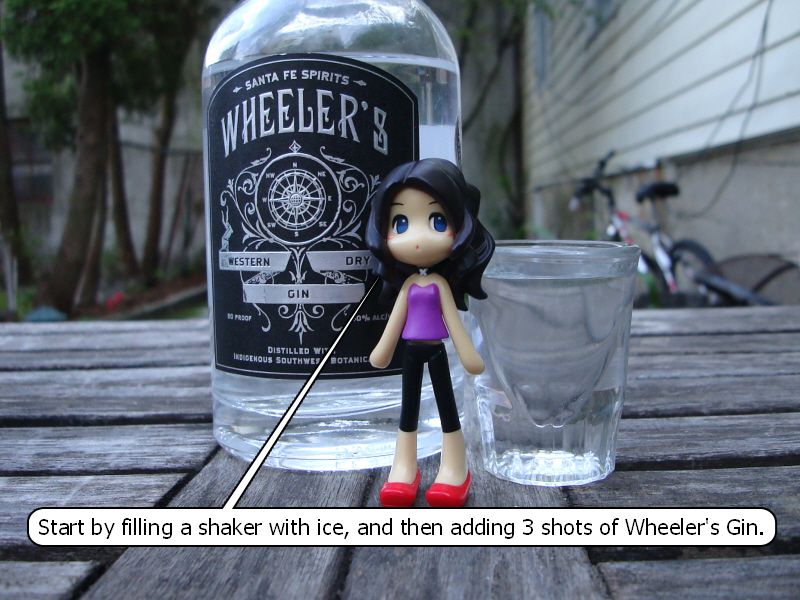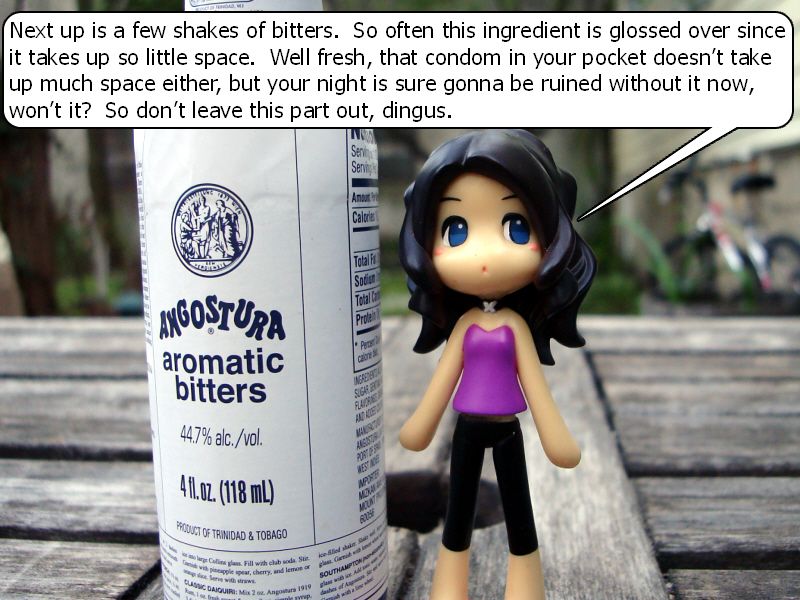Santa Fe Spirits has been nice enough to provide us with some, so that we can show you that there's more to Gin than just throwing half the ingredients of Italian salad dressing into a bunch of vodka and calling it a day. Wheeler's Gin is certainly not some conjurer of cheap tricks that, and not only contains the familiar gin botanicals, but also ones that are unique to its home in the American Southwest. Check out our martini we made with it here.
But now on to The Yankee Rose.

Ingredients you will need:
1) Gin. A gin that is much more designed to carry numerous flavors to your nose after you sip it, rather than jump straight up there before you even get even the first bit down. While originally intended for the very soft and primarily lavender Brooklyn Gin (hence calling it the Yankee Rose seemed almost obligatory), Wheeler's Gin from Santa Fe Spirits was a great fit for this. Additionally, we are still amazed that a distillery from New Mexico is producing top-shelf spirits like Gin and Applejack, which are so often thought of as East Coast territory. If you don't want to use alcohol, check out our alcohol-free version of this on our tumblr.
2) Rose Water. This stuff has been used by civilization for many things over the centuries. A great way to flavor baked goods, teas, or add a little something different to soft drinks, Rose Water is even something you can make at home (here's a video of some lady showing you how). But Disclaimer; If you don't know exactly what the rose pedals have been through, like if they've been chemically treated by a florist or have been otherwise exposed to things not for eating, then just go pick up some Alwadi Rose Water. It's not hard to find, and they specifically make it for edible uses. So you can feel safe and secure knowing that someone somewhere had made sure you aren't getting bad chemical stuff. This stuff also lasts quite a while in the fridge, so you'll be able to use it for many different applications.
3) Simple Syrup. This shouldn't be hard. Seriously, if you don't know how to do this by now you might want to go practice right now.
4) Seltzer. It is important that you use seltzer/soda water with absolutely nothing added to it. No minerals, flavors, or anything else. This is a delicate drink and that stuff can throw things off.
5) Shaker and Ice. The same goes for ice. If your tap water often has strong smells or certain flavors to it (be they good or bad) then avoid using it for this and use filtered or distilled water for the ice to be used here. It's easy to torpedo a drink of top-shelf everything only to shake it over ice from the nastiest water available.
6) Bitters. You can really use whatever bitters you like, and we're hoping to feature some unique ones here soon, but for now, you will see us use Angostura.
7) Citric Acid. Here's the part where lots of you are going to say "What? I can't get all chemistry-lab intense into this." But this stuff is as easy to find as sugar, costs about the same, and dissolves in cold water as well. That little pack up there (when full) was less than $2 and we picked it us at our local Lebanese Spice Shop. We know not many of you are gonna have a local Lebanese Spice Shop, but don't worry, the stuff is still everywhere and is often used by health-conscious people as a meat-tenderizer. It's also sometimes called "Lemon-Salt" but it's got no lemon flavor or actual salt in it.
8) Pint Glass. That's what we're making this in, but once you get this down, you can decide for yourself how you want it.
DON'T you dare try to just add lemon juice or something to this instead of citric acid. Citric acid has no flavor and won't upset the flavor balance in this (it only lowers the PH a little bit). If you throw citrus juice in there then that's all you're gonna taste in this.




The level of sweetness is always subjective, but you will want it to be on the sweeter side of your usual range, as that quality really compliments the rose water's natural flavors and fragrances.



A tiny bit of this stuff goes a long way. Just 1/8th of a teaspoon can probably drop it a full PH point, so always add the smaller amount you think you will need and then add more if you want. We find that about a quarter works best for us, maybe a bit more or less depending what kind of mood we're in.


Before you do anything else, if your cocktail shaker is metal, then rinse it out right here and now. You just put citric acid in there, you don't want a residue of that sticking to the insides for hours after this and start munching away at the metal do you?


This is by far the most fragrant and fragile drink we've ever done. You can miss the mark only a little on it, and end up with something you don't like, so it's not for the timid. But once you get the hang of it, you'll be able to show your friends/co-workers/bosses/neighborhood drug dealers a great warm-weather cocktail that no one has ever seen before.
It should be noted that it is possible to not add Gin and make this an alcohol-free beverage. In fact, it was the alcohol-free version we made on a whim, which led us to this new discovery.

We would like to thank Santa Fe Spirits for participating is this recipe, and check out our next episode where we feature Wheeler's Gin in Colin's Collins. ...go buy some.
We'd also like to thank Al Wadi, Angostura, and The Boylan Bottling Co. for ...making the delicious things we bought for this. Please keep making nummie things.


No comments:
Post a Comment